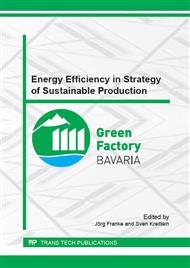[1]
Deutsche Bundesregierung, Energiekonzept für eine umweltschonende, zuverlässige und bezahlbare Energieversorgung, (2010).
Google Scholar
[2]
M. Klobasa, G. Angerer, A. Lüllmann, J. Schleich, T. Buber, A. Gruber, M. Hünecke, and S. von Roon, Load Management as a Way of Covering Peak Demand in Southern Germany, Agora Energiewende, München, (2014).
Google Scholar
[3]
G. Reinhart, S. Reinhardt, and M. Graßl, Energieflexible Produktionssysteme, Einführungen zur Bewertung der Energieeffizienz von Produktionssystemen, wt Werkstattstechnik Online, vol. 102, no. 9, p.622–628, http: /fhgonline. fhg. de/bibliotheken/iwu/energieflexible. pdf, (2012).
DOI: 10.37544/1436-4980-2012-9-622
Google Scholar
[4]
M. Graßl and G. Reinhart, Evaluating measures for adapting the energy demand of a production system to volatile energy prices, Procedia CIRP, vol. 15, p.129–134, (2014).
DOI: 10.1016/j.procir.2014.06.081
Google Scholar
[5]
J. Horstmann, Operationalisierung der Unternehmensflexibilität: Entwicklung einer umwelt- und unternehmensbezogenen Flexibilitätsanalyse, 1st ed. Wiesbaden: Deutscher Universitäts-Verlag, (2007).
Google Scholar
[6]
M. Schenk, S. Wirth, and E. Müller, Factory Planning Manual. Berlin, Heidelberg: Springer Berlin Heidelberg, (2010).
Google Scholar
[7]
E. Müller, J. Engelmann, S. Jörg, and T. Löffler, Energieeffiziente Fabriken planen und betreiben. Berlin, Heidelberg: Springer-Verlag Berlin Heidelberg, (2009).
DOI: 10.1007/978-3-540-89644-9
Google Scholar
[8]
S. Thiede, Energy efficiency in manufacturing systems. Berlin, New York: Springer, (2012).
Google Scholar
[9]
P. Schnellbach and G. Reinhart, Evaluating the Effects of Energy Productivity Measures on Lean Production Key Performance Indicators, Procedia CIRP, vol. 26, p.492–497, (2015).
DOI: 10.1016/j.procir.2014.07.094
Google Scholar
[10]
N. Weinert, S. Chiotellis, and G. Seliger, Methodology for planning and operating energy-efficient production systems, CIRP Annals - Manufacturing Technology, vol. 60, no. 1, p.41–44, (2011).
DOI: 10.1016/j.cirp.2011.03.015
Google Scholar
[11]
M. Rager, Energieorientierte Produktionsplanung: Analyse, Konzeption und Umsetzung, 1st ed. Wiesbaden: Gabler, (2008).
Google Scholar
[12]
F. Keller, C. Schönborn, and G. Reinhart, Energy-orientated Machine Scheduling for Hybrid Flow Shops, Procedia CIRP, vol. 29, p.156–161, (2015).
DOI: 10.1016/j.procir.2015.02.103
Google Scholar
[13]
C. Schultz, P. Sellmaier, and G. Reinhart, An Approach for Energy-oriented Production Control Using Energy Flexibility, Procedia CIRP, vol. 29, p.197–202, (2015).
DOI: 10.1016/j.procir.2015.02.038
Google Scholar
[14]
J. Gausemeier and C. Plass, Zukunftsorientierte Unternehmensgestaltung: Strategien, Geschäftsprozesse und IT-Systeme für die Produktion von morgen, 2nd ed. München: Hanser, (2014).
DOI: 10.3139/9783446438422
Google Scholar
[15]
R. Hernandéz and H. -P. Wiendahl, Die wandlungsfähige Fabrik - Grundlagen und Planungsansätze, in Technological economics, Bd. 60, Erfolgsfaktor Flexibilität: Strategien und Konzepte für wandlungsfähige Unternehmen, B. Kaluza and S. Behrens, Eds, Berlin: Schmidt, 2005, p.203.
Google Scholar
[16]
J. Hambach and F. Albrecht, Methoden der Szenariotechnik in der Fabrikplanung: Vorschlag für einen Gliederungsansatz zur Auswahl der passenden Technik, ZWF - Zweitschrift für wirtschaftlichen Fabrikbetrieb, vol. 109, no. 3, p.117–120, (2014).
DOI: 10.3139/104.111103
Google Scholar
[17]
G. Pawellek, Ganzheitliche Fabrikplanung: Grundlagen, Vorgehensweise, EDV-Unterstützung, 2nd ed. Berlin, Heidelberg: Springer Vieweg, (2014).
DOI: 10.1007/978-3-662-43728-5
Google Scholar
[18]
R. Pilipp, Die Planung flexibler Produktionssysteme, Zeitschrift für wirtschaftliche Fertigung, vol. 68, no. 11, p.632–637, (1973).
DOI: 10.1515/zwf-1973-681108
Google Scholar
[19]
F. Karl, P. Schnellbach, G. Reinhart, J. Böhner, S. Freiberger, R. Steinhilper, S. Kreitlein, J. Franke, T. Maier, J. Pohl, and M. F. Zäh, Green Factory Bavaria - Demonstrations-, Lehr- und Forschungsplattform zur Erhöhung der Energieeffizienz: Green Factory Bavaria, wt Werkstattstechnik Online, vol. 102, no. 9, p.629–632, (2012).
DOI: 10.37544/1436-4980-2012-9-629
Google Scholar


